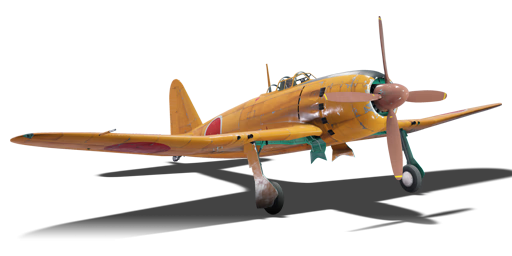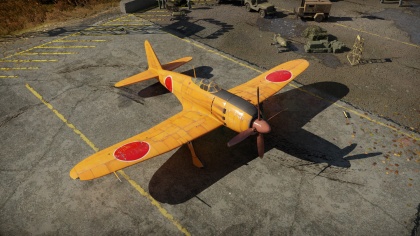Difference between revisions of "A7M1 (NK9H)"
(→History) |
m (→Pros and cons) |
||
| Line 210: | Line 210: | ||
* Elevator lock up above 500+ km/h IAS | * Elevator lock up above 500+ km/h IAS | ||
* Slow roll rate | * Slow roll rate | ||
| + | * cannons have (very) low rate of fire | ||
== History == | == History == | ||
Revision as of 18:38, 11 November 2020
Contents
| This page is about the Japanese premium fighter A7M1 (NK9H). For the regular version, see A7M2. |
Description
The A7M1 Reppu (NK9H) is a premium rank IV Japanese fighter
with a battle rating of 5.0 (AB/RB) and 4.7 (SB). It was introduced in Update 1.53 "Firestorm".
The A7M1 Reppu is the prototype version of the A7M2 in the tech tree fitted with a NK9H engine. In game this fighter is a jack of all trades - excellent energy retention, amazing turn rate, and acceptable speed. These traits make the Reppu an excellent weapon for players who enjoy being the tip of the spear.
General info
Flight Performance
| Characteristics | Max Speed (km/h at 6,900 m) |
Max altitude (meters) |
Turn time (seconds) |
Rate of climb (meters/second) |
Take-off run (meters) | |||
|---|---|---|---|---|---|---|---|---|
| AB | RB | AB | RB | AB | RB | |||
| Stock | 594 | 578 | 11000 | 15.7 | 16.2 | 13.6 | 13.6 | 250 |
| Upgraded | 639 | 617 | 14.8 | 15.0 | 21 | 16.9 | ||
Details
| Features | ||||
|---|---|---|---|---|
| Combat flaps | Take-off flaps | Landing flaps | Air brakes | Arrestor gear |
| ✓ | ✓ | ✓ | X | ✓ |
| Limits | ||||
|---|---|---|---|---|
| Wing-break speed (km/h) |
Gear limit (km/h) |
Combat flaps (km/h) |
Max Static G | |
| + | - | |||
| 826 | 310 | 510 | ~12 | ~10 |
| Optimal velocities | |||
|---|---|---|---|
| Ailerons (km/h) |
Rudder (km/h) |
Elevators (km/h) |
Radiator (km/h) |
| < 400 | < 380 | < 380 | > 317 |
| Compressor (RB/SB) | ||
|---|---|---|
| Setting 1 | ||
| Optimal altitude | 100% Engine power | WEP Engine power |
| 2,000 m | 1,875 hp | 2,089 hp |
| Setting 2 | ||
| Optimal altitude | 100% Engine power | WEP Engine power |
| 6,000 m | 1,675 hp | 1,866 hp |
Survivability and armour
- 13 mm steel plate behind seat, tilted 13°
- 70 mm bulletproof glass forward of seat, tilted 24°
- Self-sealing fuel tanks
Armaments
Offensive armament
The A7M1 (NK9H) is armed with:
- 2 x 20 mm Type 99 Model 2 navy cannons, wing-mounted (200 rpg = 400 total)
- 2 x 13.2 mm Type 3 navy machine guns, wing-mounted (300 rpg = 600 total)
Suspended armament
The A7M1 (NK9H) can be outfitted with the following ordnance:
- Without load
- 2 x 60 kg Navy Type 97 Number 6 bombs (120 kg total)
Usage in battles
Describe the tactics of playing in an aircraft, the features of using vehicles in a team and advice on tactics. Refrain from creating a "guide" - do not impose a single point of view, but instead, give the reader food for thought. Examine the most dangerous enemies and give recommendations on fighting them. If necessary, note the specifics of the game in different modes (AB, RB, SB).
Manual Engine Control
| MEC elements | ||||||
|---|---|---|---|---|---|---|
| Mixer | Pitch | Radiator | Supercharger | Turbocharger | ||
| Oil | Water | Type | ||||
| Controllable | Controllable Not auto controlled |
Controllable Not auto controlled |
Controllable Not auto controlled |
Separate | Controllable 2 gears |
Not controllable |
Modules
| Tier | Flight performance | Survivability | Weaponry | ||
|---|---|---|---|---|---|
| I | Fuselage repair | Radiator | Offensive 13 mm | ||
| II | Compressor | Airframe | New 13 mm MGs | 9 in (mod30) | |
| III | Wings repair | Engine | Offensive 20 mm | ||
| IV | Engine injection | Cover | New 20 mm cannons | ||
| This is a premium vehicle: all modifications are unlocked on purchase | |||||
Pros and cons
Pros:
- Excellent energy retention
- Exceptional maneuverability below 500km/h IAS
- Great armaments
Cons:
- Engine tends to overheat
- Slow compared to allied fighters
- Elevator lock up above 500+ km/h IAS
- Slow roll rate
- cannons have (very) low rate of fire
History
In late 1940, Just after the A6M started entering its production phase, the navy requested Mitsubishi to start development of a direct successor by 1941, but due engine choice for a high-output compact engine was scarce, and the development team having their hands filled with development of the A6M2 Mod.21 and developing the J2M made Mitsubishi decide to scrap the request.
By 1942 as development of the A6M3 Mod.32 and J2M2 Mod.11 have been finished, the navy once more ordered Mitsubishi and their team to design a direct successor which would be faster and as nimble as the Zero, but as before, engines which would suit the plane were still in development and the team had to design a plane while still having to wait on a viable engine.
As development of the A7M platform came to an end, the last set piece and main problem of the A7M development, being the engine led to the first prototype to make use of the Nakajima NK9 "Homare". This singular plane would be the first A7M and respectively would become the A7M1 and a trial flight would be performed on the 6th of May, 1944.
While the wingload was acceptable of 150 kg/m², maneuverability and handling were excellent but the engine was simply underpowered and couldn't meet the speed requirements the Navy were looking for and ended up in a disappointed cancel of the project.
But as Mitsubishi already got a greenlight to use Mitsubishi's home-made engine with the MK9 beforehand, the project sparked interest once more for the Navy with the A7M2.
Media
Excellent additions to the article would be video guides, screenshots from the game, and photos.
See also
Links to the articles on the War Thunder Wiki that you think will be useful for the reader, for example:
- reference to the series of the aircraft;
- links to approximate analogues of other nations and research trees.
External links
Paste links to sources and external resources, such as:
- topic on the official game forum;
- encyclopedia page on the aircraft;
- other literature.
| Mitsubishi Company (三菱商会) | |
|---|---|
| Fighters | A5M4 · Hagiri's A5M4 |
| A6M2 mod. 11 · A6M2 · A6M3 · A6M3 mod. 22 · A6M3 mod. 22Ko · A6M5 · A6M5 Ko · A6M5 otsu · A6M5 Hei · A6M6c | |
| A7M1 (NK9H) · A7M2 | |
| J2M2 · J2M3 · J2M4 Kai · J2M5 · J2M5 (30 mm) | |
| Hydroplanes | F1M2 |
| Interceptors | Ki-83 · Ki-109 |
| Bombers | G4M1 |
| Ki-21-Ia · Ki-21-I hei · Ki-67-I Ko · Ki-67-I otsu | |
| Jet Fighters | Ki-200 |
| Captured | ▃A6M2 · ␗A6M2 |
| See also | Mitsubishi Heavy Industries, Ltd. (Post-War) |
| Japan fighters | |
|---|---|
| Navy | |
| Carrier-based fighter | |
| A5M | A5M4 · Hagiri's A5M4 |
| A6M | A6M2 mod. 11 · A6M2 · A6M3 · A6M3 mod. 22 · A6M3 mod. 22Ko · A6M5 · A6M5 Ko · A6M5 otsu · A6M5 Hei · A6M6c |
| A7He | A7He1* |
| A7M | A7M1 (NK9H) · A7M2 |
| Land-based Fighter | |
| J2M | J2M2 · J2M3 · J2M4 Kai · J2M5 · J2M5 (30 mm) |
| J6K | J6K1 |
| J7W | J7W1 |
| N1K-J | N1K1-Ja · N1K2-J · N1K2-Ja |
| Fighter seaplane | |
| N1K | N1K1 |
| A6M-N | A6M2-N |
| Army | |
| Ki-10 | Ki-10-I · Ki-10-I C · Ki-10-II · Ki-10-II C |
| Ki-27 | Ki-27 otsu · Ki-27 otsu Tachiarai |
| Ki-43 | Ki-43-I · Ki-43-II · Ki-43-III otsu |
| Ki-44 | Ki-44-I · Ki-44-I 34 · Ki-44-II otsu · Ki-44-II hei |
| Ki-61 | Ki-61-I ko · Ki-61-I otsu · Ki-61-I hei · Tada's Ki-61-I hei · Ki-61-I tei · Ki-61-II Otsu Kai |
| Ki-84 | Ki-84 ko · Ki-84 otsu · Ki-84 hei |
| Ki-87 | Ki-87 |
| Ki-94 | Ki-94-II |
| Ki-100 | Ki-100 · Ki-100-II |
| Other countries | ▅F4U-1A · ▅P-51C-11-NT · ▅Bf 109 E-7 · ▅Fw 190 A-5 |
| *Imported designation of the He 112 (A6M was in development - A7M would take A7 designation after the cancelation of the A7He) | |
| Japan premium aircraft | |
|---|---|
| Fighters | Hagiri's A5M4 · A7He1 · Ki-27 otsu Tachiarai |
| Ki-44-II otsu · ▅Bf 109 E-7 · ▅F4U-1A · Ki-100-II · Ki-44-I 34 | |
| ▅Fw 190 A-5 · A7M1 (NK9H) · Tada's Ki-61-I hei · ▅P-51C-11-NT | |
| J2M4 Kai · A6M5 Ko · A6M6c · J2M5 · Ki-87 · J6K1 | |
| Twin-engine fighters | Ki-96 |
| Jet fighters | F-86F-40 JASDF▅ · T-2 Early · F-4EJ ADTW |
| Strike aircraft | ▄AV-8S |
| Bombers | Ki-21-I hei · Ki-48-II otsu · H8K3 · B7A2 (Homare 23) · ▅B-17E |





